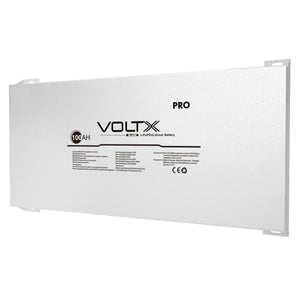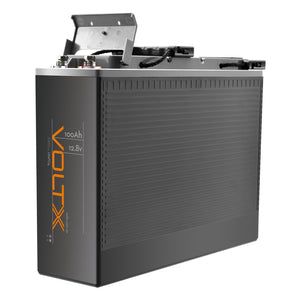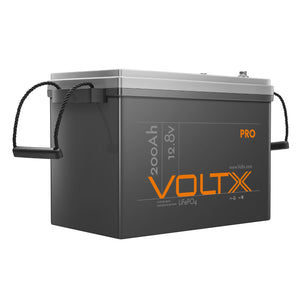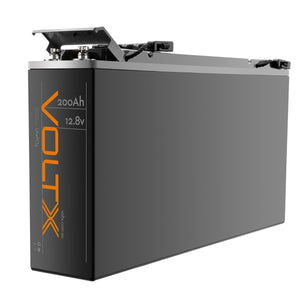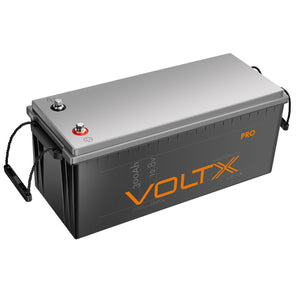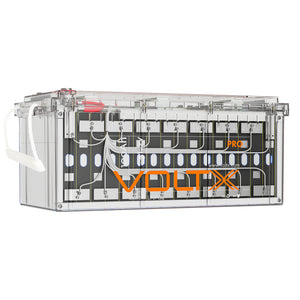Whether you're exploring the rugged Australian Outback in your caravan, sailing along our beautiful coastlines, or setting up an off-grid solar system for your remote property, reliable power is essential. At the heart of these power systems sits the deep cycle battery, a crucial component designed specifically for sustained, deep discharges rather than the quick bursts of power that standard car batteries provide.
Unlike starting batteries found in vehicles, deep cycle batteries, such as the Outbax 100Ah Lithium Battery or the Outbax Pro 200Ah Battery, excel at delivering steady power over extended periods, making them ideal for applications where consistent energy is needed for hours or days including, solar energy storage, marine equipment, and RV power systems. With numerous options available in today's market, finding the best deep cycle battery for your specific requirements can seem challenging, but understanding a few key factors will help you make an informed decision.
Understanding Deep Cycle Batteries
A deep cycle battery functions fundamentally differently from a regular starting battery, as it's engineered to provide a consistent flow of power over prolonged periods rather than delivering high current in short bursts. What makes deep cycle batteries special is their construction with thicker plates that allow them to withstand repeated cycles of significant discharge followed by recharging without degrading quickly, such as the 200Ah LiFePO4 Battery.
These batteries typically operate by discharging between 50-80% of their capacity regularly, depending on the chemistry, whereas starting batteries are designed to discharge only about 2-5% of their capacity before being recharged by an alternator. This fundamental difference in design and function makes deep cycle batteries indispensable for applications requiring sustainable power delivery over time, such as solar energy storage, marine equipment operation, and recreational vehicle power systems.
Key Factors When Choosing a Deep Cycle Battery
When selecting the perfect deep cycle battery for your setup, several critical specifications demand your attention. Capacity, measured in Amp-hours (Ah), indicates how much energy the battery can store and deliver over time. A 100Ah deep cycle battery might power basic camping needs, while 200Ah or 300Ah deep cycle batteries suit more extensive setups with higher power demands. Voltage requirements typically centre around 12V deep cycle batteries for most standard applications, though larger systems might utilize 24V or 48V configurations for increased efficiency.
Battery chemistry represents perhaps the most significant decision point, with modern lithium iron phosphate (LiFePO4) technology rapidly replacing traditional lead-acid variants like AGM (Absorbent Glass Mat), which offer superior longevity, lighter weight and faster charging. Understanding these specifications in relation to your power requirements will guide you toward a battery that delivers reliable performance without unnecessary expense or excess capacity.
Why LiFePO4 Batteries Stand Out Among Other Batteries
The lithium deep cycle battery, particularly those utilising LiFePO4 (lithium iron phosphate) technology, has revolutionised portable power solutions across Australia. These advanced batteries offer remarkable advantages over traditional lead-acid alternatives, boasting up to 10 times longer lifespan (typically 2,000-5,000 cycles compared to 300-500 for lead-acid), significantly lighter weight (often 60-70% lighter), substantially faster charging capabilities, and the ability to be discharged to 80-90% capacity without damage versus just 50% for AGM batteries. Additionally, they feature built-in Battery Management Systems (BMS) for enhanced safety.
A quality LiFePO4 battery delivers consistent voltage throughout its discharge cycle, ensuring your appliances receive steady power until the battery is nearly depleted, while also offering enhanced safety with minimal risk of thermal runaway compared to other lithium chemistries. Though initially more expensive than AGM deep cycle batteries, the extended lifespan and superior performance of LiFePO4 batteries typically result in better long-term value, especially for frequent users in demanding Australian conditions.
Choosing Deep Cycle Batteries for Different Applications
Your specific usage scenario should heavily influence your deep cycle battery selection. For solar setups, deep cycle batteries are indeed excellent choices as they efficiently store energy harvested during daylight hours.LiFePO4 batteries are particularly well-suited for this due to their charge efficiency exceeding 98% and ability to withstand thousands of charge cycles.
Marine environments demand deep cycle marine batteries that can withstand constant vibration, salt spray, and limited maintenance opportunities—features found in sealed designs with robust construction. Similarly, the best deep cycle RV battery will combine space efficiency with reliable performance across varying temperature conditions while providing sufficient capacity for extended periods away from shore power.
By matching battery specifications to your particular application—whether it's powering a coastal fishing boat, supporting an off-grid holiday in your caravan, or backing up a remote property's solar system—you'll ensure optimal performance and longevity from your investment.
-
Solar Setups: Choose a battery like the 170Ah LiFePO4 Solar Battery, offering >98% charge efficiency for reliable energy storage.
-
Marine Environments: Use sealed, robust designs resistant to vibration and salt spray, such as the Marine Deep Cycle Battery.
-
Recreational Vehicles: Opt for space-efficient designs like the 100Ah Slimline Lithium Battery, capable of delivering reliable performance in varying temperatures.
How To Maintain Your Deep-Cycle Batteries
To maximize the lifespan and performance of your deep cycle battery, regularly inspect connections to ensure terminals are free from corrosion and securely attached. Periodically monitor the battery's voltage to confirm it operates within the recommended ranges. Always use chargers specifically designed for LiFePO4 batteries to avoid potential damage and inefficiencies. Proper storage is essential; keep the battery in a cool, dry location and maintain a charge level of 50-80% when not in use to prevent capacity degradation. Additionally, avoid over-discharging the battery by recharging it before it drops below 20% capacity. Adhering to these maintenance practices not only extends the battery's life but also helps uphold a 5-year warranty, providing reliable performance.
Selecting the Best Battery for Your Setup
Selecting the ideal deep cycle battery ultimately requires balancing your power needs, available space, budget, and performance expectations. Begin by calculating your energy requirements—list all devices you'll power, their consumption rates, and estimated usage times to determine the minimum capacity needed. Consider future expansion possibilities and typically aim for 20% additional capacity beyond your calculated needs. Evaluate the environment where your battery will operate, as extreme temperatures and physical conditions may necessitate specific features or protective measures.
While premium lithium options from trusted brands may represent a larger initial investment, their extended cycle life, minimal maintenance requirements, and consistent performance often deliver superior long-term value compared to budget alternatives. Remember that a good deep-cycle battery isn't necessarily the most expensive one, but rather the one that reliably meets your specific requirements while offering the best balance of performance, durability, and value.
Frequently Asked Questions
What is a deep cycle battery?
A deep cycle battery is specifically designed to provide steady power over extended periods and can be repeatedly discharged by up to 80% of its capacity (depending on chemistry) before recharging. Unlike starting batteries that deliver short bursts of high current, deep cycle batteries feature thicker plates and different internal chemistry optimised for sustained, regular deep discharges without premature failure.
Are deep cycle batteries good for solar?
Yes, deep cycle batteries are excellent for solar energy storage systems. They efficiently store electricity generated by solar panels during daylight hours for use when the sun isn't shining. LiFePO4 batteries are particularly well-suited for solar applications due to their high charge efficiency, extended cycle life, and ability to deliver consistent power output throughout their discharge cycle.
What is the best deep cycle battery?
There isn't a single "best" deep cycle battery for all situations, as the ideal choice depends on your specific application, capacity requirements, budget, and preferences regarding weight and lifespan. However, LiFePO4 batteries generally offer superior performance characteristics across most metrics, including cycle life, charge efficiency, depth of discharge capability, and weight. For demanding applications or frequent use, premium lithium options typically represent better long-term value despite higher initial cost.
How do I choose the right size (Ah) deep cycle battery?
To determine the appropriate capacity, calculate your total power requirements by listing all devices you'll operate, their power consumption (in watts or amps), and estimated run times. Convert these figures to amp-hours required per day, then factor in the recommended maximum discharge depth for your battery type (typically 50% for AGM or 80% for lithium). Finally, consider additional capacity for unexpected needs or future expansion, typically adding 20% to your calculated requirement.

